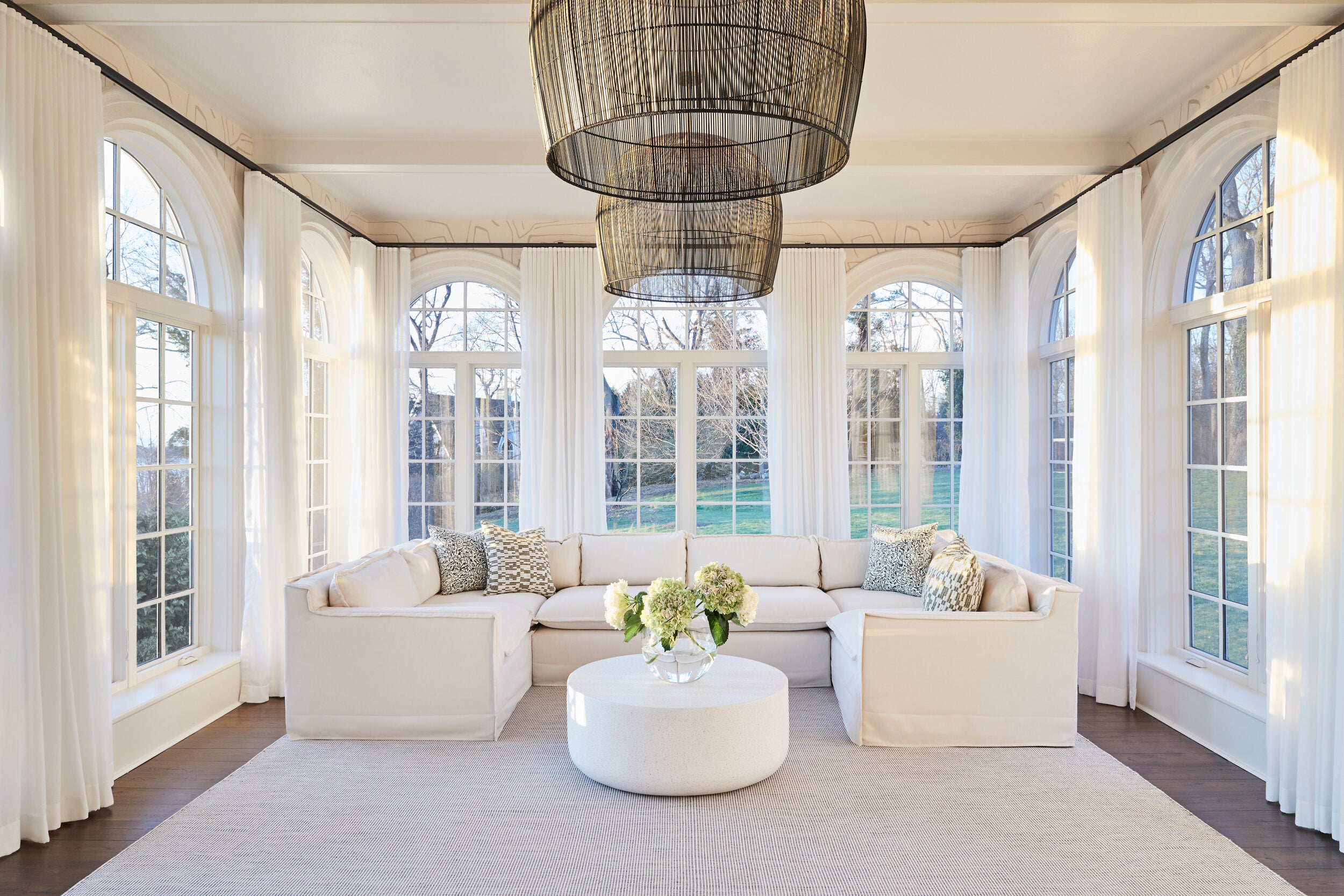Flat Panel Curtains & Window Drapes: A Complete Guide
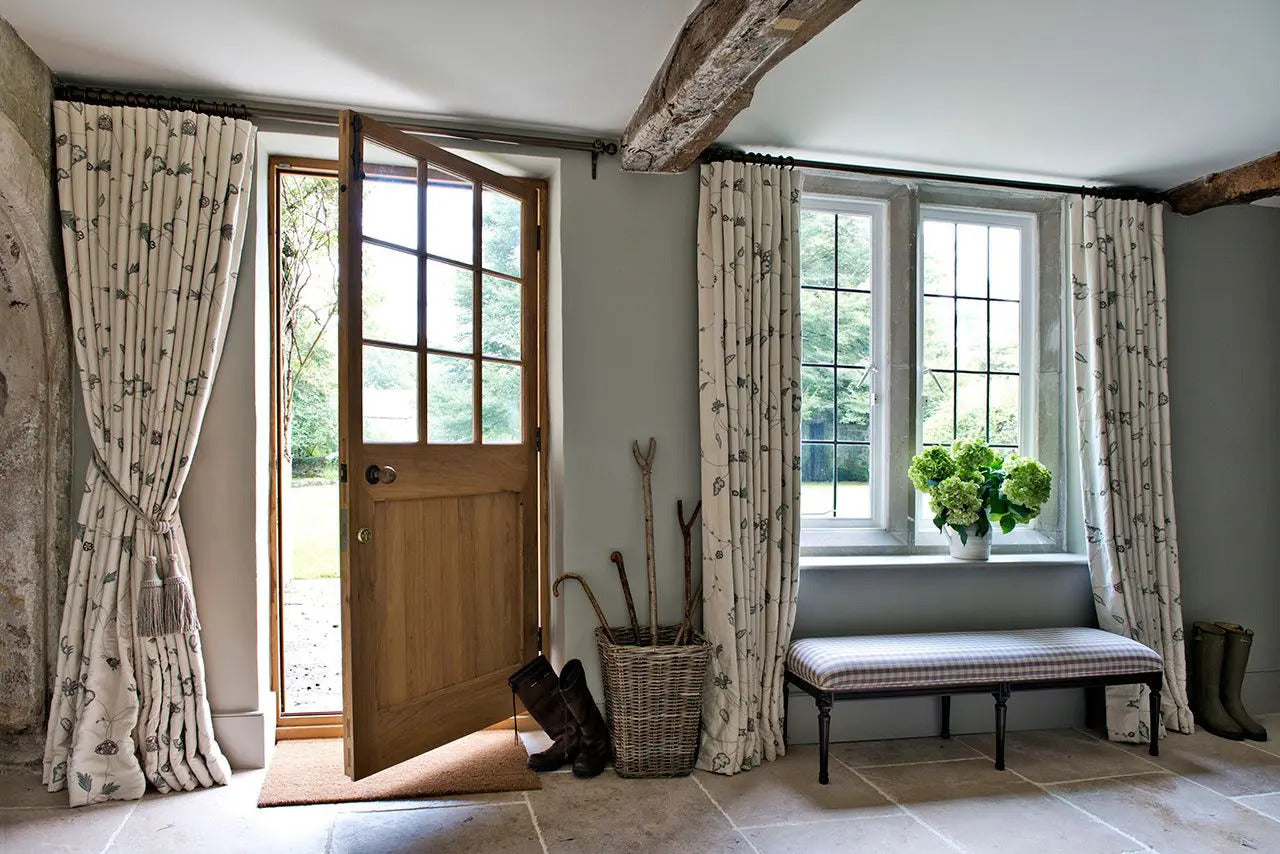
Image by Sims Hilditch / Polly Eltes
If you are looking for custom drapes with simple elegance and impressive operational ease, our flat panel top curtains will meet you there. Sporting the most simplified of constructs possible for drapery, flat panel curtains can bring effortless refinement to any window. Shunning elaborate pleats and ruffled headers, flat panel top drapes offer a clean-lined silhouette on which the fabric can stand out and do all the talking.
With symmetrical pleats that offer a sculptural finish to the drapery, flat panels prove their candidacy for formal decor without being overly ornate or elaborate. At the same time, they reserve their place in casual decor by their simple construct. With the capacity to be dressed up or down as much as required, flat panels prove to be one of the most versatile styles of drapery on offer.
From the most frequently operated bedroom windows to the light-welcoming patio doors, you will find flat panel curtains doing their job everywhere with finesse. While this style finds its most apt placement in modern homes with casual leanings, it is also compatible with transitional and traditional spaces when designed with the right fabric.
If you want to adorn your home with the subtle refinement of flat panel top curtains, here’s everything you need to know about them. Get hold of some handy styling tips from our in-house home decorators and learn the tricks to making the most of your flat panel top drapes. Read on!
What are Flat Panel Top Curtains?
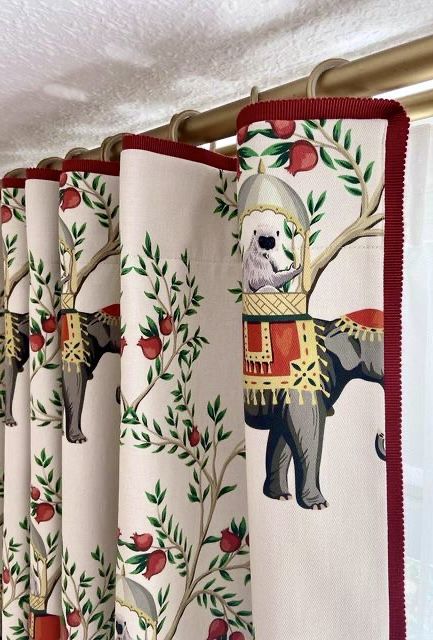
Image by Artessuto
Flat panel top curtains are simple fabric panels hemmed on all four sides with the header tape at the back. The header is plain on the front with no stitched-in pleats, ruffles or decorative loops. The pleats are formed by gathering the panels on the track or pole just like in styles such as rod pocket drapes and grommet curtains. Since there are no ‘pinches or puckers’ to break the flow, the pleats hang straight from top to bottom, offering a flawlessly uniform and wavy contour on the frontage.
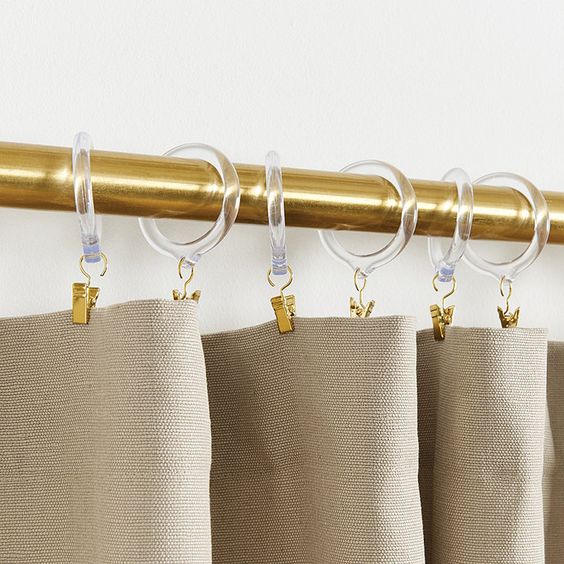
Image by Ballard Designs
Flat panel top drapes can be dressed to give different looks based on their fabric composition and how they are mounted on the pole/track. For example, they can be planned with deep, shape-holding pleats on a heavy fabric for a dramatic edge or with shallow pleats on a lightweight fabric for a simpler, more light-filtering approach. This flexibility is possible because the pleats are not ‘fixed’ as is the case with pinch pleat drapery, and the look can vary based on how the hardware is set up. More on this further below, keep reading!
What are the Reasons to Choose Flat Panel Top Curtains?
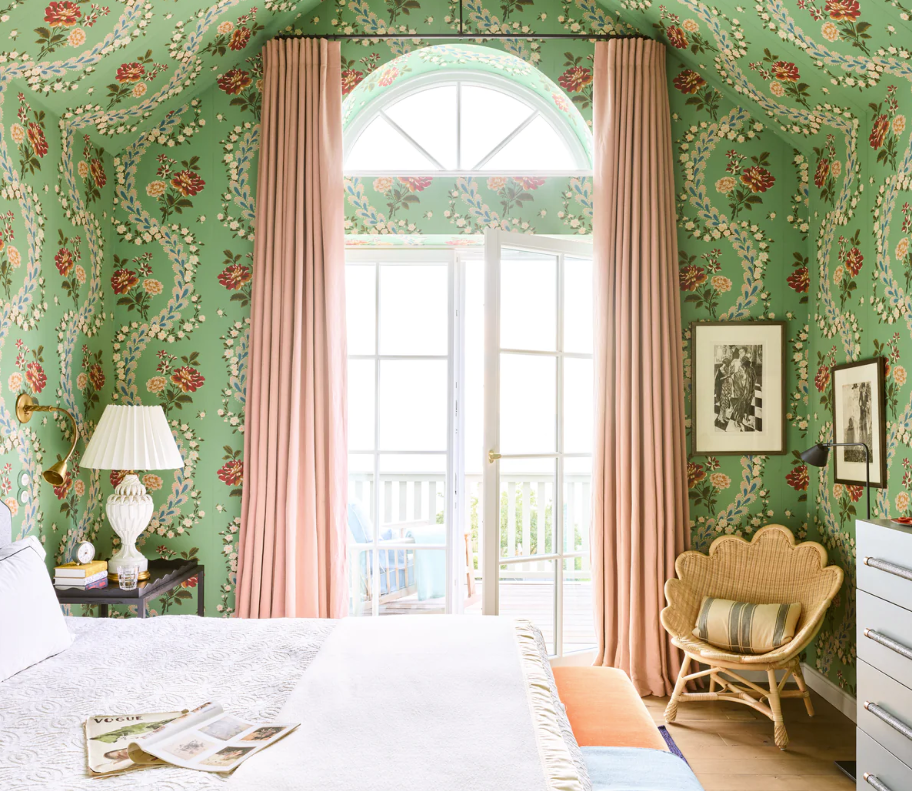
Image by Beata Heuman
Curtains are often the final touch in the interior decor. They set the mood of the space besides fulfilling the function of providing privacy and light control. Given the range of needs to be addressed and the aesthetic aspirations behind installing curtains, both homeowners and designers may keenly consider whether flat panels are the best choice. While every heading style proffers a unique combination of visual appeal and functionality, certain traits set flat panels apart from others. And, in some situations, they may be your perfect go-to candidate. Let’s unfold for you the top reasons to opt for flat panels:
PERFECT ‘WAVY’ CONTOUR: Flat panel top curtains portray smooth round pleats spread across the panel with uniform fullness and perfect symmetry. This perfectly wavy contour of the drapery flows from the topmost point of the drapery to the bottom without any visual breaks as the header is constructed without any folds or pleats. When stitched with drapery weight fabrics, the drapery dons a sculptural visual appeal with shapely, symmetrical pleats and that’s what most clients fall for.
MODERN APPEAL: Given the minimalist header and the possibility to create elegance even with low fullness unlike elaborate heading styles, flat panel curtains have become one of the most preferred options for modern minimalist homes.
EASY MOVEMENT: Flat tops hang on rings, so they glide easily on the pole/track. You can dress frequently operated windows with them and be assured that they will function smoothly without any fuss.
ADVANTAGEOUS FOR LAYERED CURTAINS: Having a sleek header without any stitched-in ‘projecting’ folds or pleats is of great advantage when layering curtains on double-configuration drapery rods. Space the drapery pins/clips closer so that you form shallow pleats. With this sleek header, flat panels will operate without infringing on the space of the top layer of curtains. Both layers of curtains can operate smoothly at the same time.
HARDWARE COMPATIBILITY: No matter what hardware you have in place - poles or tracks - your flat panel top curtains can sync in without second thoughts. So, if you’re looking for curtains to go with your current hardware, trust this drapery to not burden you with more hardware requirements.
WIDTH ADAPTABILITY: As flat panel top curtains are not sewn with fixed, pre-stitched pleats like in the case of pinch pleat headers, they offer a certain amount of flexibility on ‘pole coverage’. A 300cm wide panel can be mounted and gathered on a 100 cm long pole, providing lush pleats and dense fall, or be stretched over a 200 cm long pole to give shallower pleats and sparse gather. This means that you can be less anxious about getting highly precise width measurements as a shortcoming will hardly make any difference. Also, you can interchangeably use these curtains for different windows if you need to do it at some point in time.
What are the Factors to Consider When Shopping for Flat Panel Top Curtains?
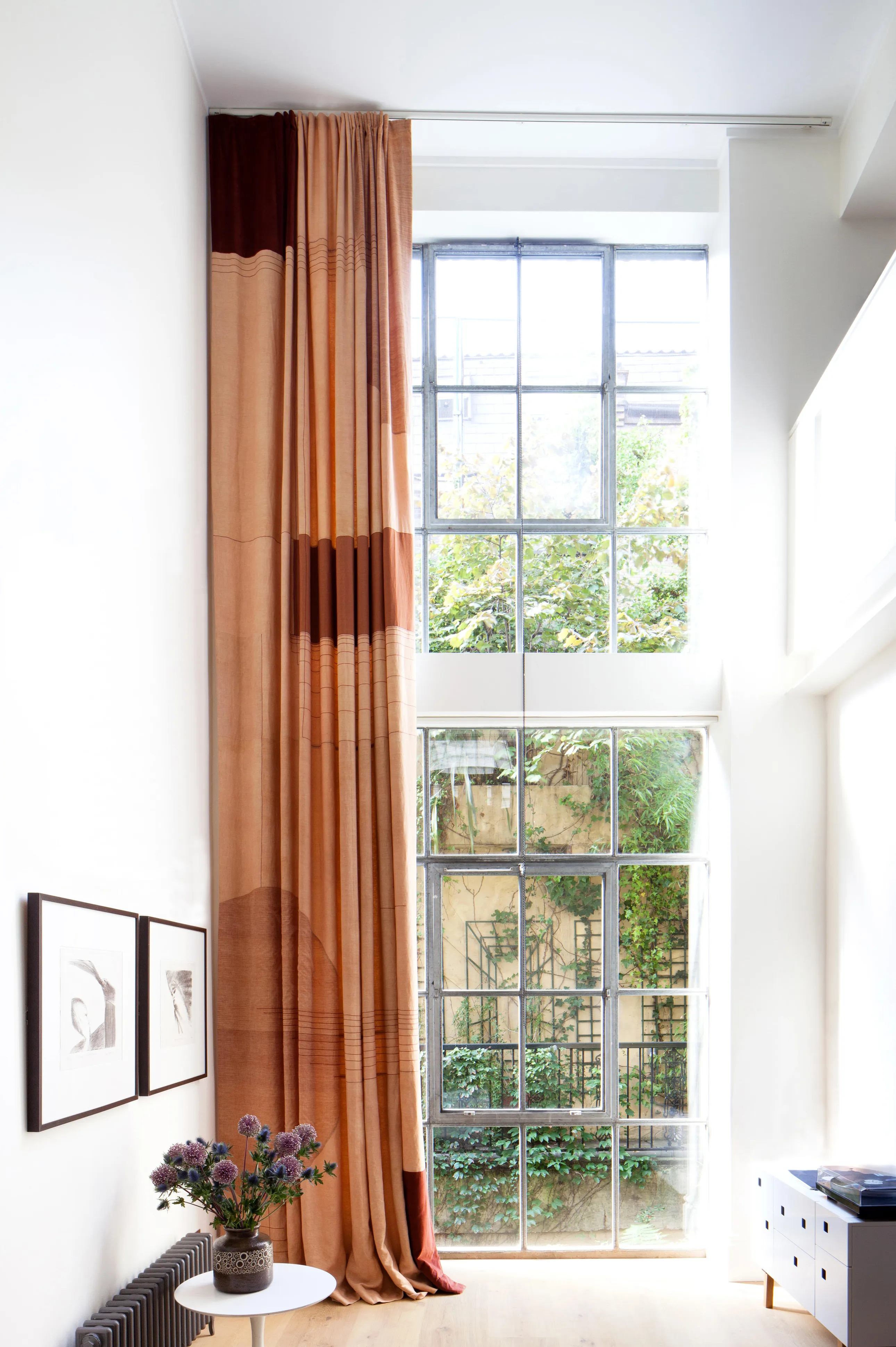
Image by Nest Design
Flat panel top curtains fulfill their functional role with praiseworthy efficiency and are versatile enough to dress any room and any type of window of your home. That makes them the go-to style for home designers and homeowners alike. By making a few considerations before shopping, you can get them to suit right for your home too. These are a few recommendations from our designers:
COMPATIBILITY WITH DECOR STYLE: Flat panel drapes can forward the creative vision of a variety of interior design styles. They are one of the most sought styles in modern homes and contemporary decor styles owing to their clean-lined silhouettes and simple construction.
That said, while they are not the obvious choice for classical, ornate settings owing to their simple construction, many clients still choose this style - and balance its minimalist nature by picking fabrics that relay a classical theme. Our stylists also recommend ‘overtreating’ flat panel drapes with stylishly pleated valances to sync in period homes and formal rooms.
Dressed in heavyweight fabrics and deep pleats, flat panel curtains take on a formal elite aesthetic. Whereas, with lightweight fabrics and closely-placed shallow pleats, they take on a non-constructed appeal that is fitting for casual spaces.
The heading style per se is not casual or formal, but the way it is designed makes all the difference. So, depending on the look you are going for, you may select the suitable fabric and space the pleats appropriately.
MEASURING & MOUNTING TECHNIQUE: Flat panel curtains offer further creative liberty to decide the end look based on the panel width as well as how they are mounted. We will explain both in detail ahead.
-
DECIDE THE PANEL WIDTH: A flat panel has no fixed, stitched-in pleats like pinch pleat drapes do; instead it forms its pleats when hand-gathered on the pole. So, the simple thumb rule is to order more width for more pleats. We recommend a minimum of 1.5x-2x fullness so that the drapery will produce a beautiful wavy contour. That translates to a curtain width that is 1.5 to 2 times the width of the window. For example, if your drapery pole is 100 cm long, we recommend ordering a single drapery panel with a width of about 150-200 cm (100 x 1.5 = 150cm, 100 x 2 = 200cm), or a pair of curtains with a panel width of about 75-100cm each. Higher fullness and width will offer denser gather, while lower will yield sparser, less full look on the same size pole.
-
DECIDE THE PLEAT DEPTH: Flat panel curtains are mounted onto the pole/track with drapery pins or clips. If you space the pins closer, the drapery will form more pleats with shallow depth. And, if you space the pins farther, the same panel will provide deeper, rounder - but fewer - pleats. We suggest spacing your drapery pins/clips about 10-20cm apart depending on whether you prefer denser, shallower pleats or deeper, looser pleats. If you prefer your flat panels to have deep pleats, we suggest inserting the pins around 17-20cm apart. On the other hand, for a relatively flatter look but with more pleats, insert your pins closer together at approximately 10-15cm intervals.
What are the Hardware Options for Flat Panel Curtains?
Flat panels are a versatile style of curtains that can be mounted on both poles and tracks. Accordingly, the hardware options will vary.
HANGING FLAT PANEL CURTAINS ON DRAPERY POLES
For drapery poles, you will need either drapery clips or eyelet rings & drapery pins. Both methods are functionally efficient, but offer slightly different visual appeals. Let’s elaborate:
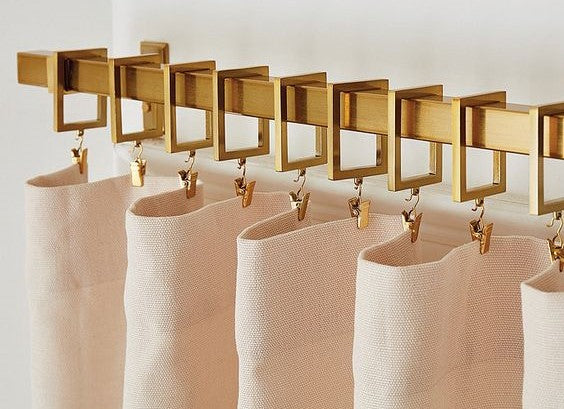
Image by Ballard Designs
DRAPERY CLIPS: The drapery clips are clamped on the seams of the header and are visible on the front side. Thus, the panel hangs a bit below the drapery pole exposing the entire ring and clip. This also adds additional length to the panel, offering a convenient solution for a curtain that might have fallen short in length. But, it also lets in plenty of light from above the header, making it a less-than-ideal option for bedrooms and nurseries, unless there is another light-blocking treatment to make up for the chinks.
DRAPERY RINGS & PINS: In the second option - the ring and pin combination - the drapery pins are hooked into the header tape on the rear side of the drapery. The curtain panel sits close to the drapery pole, and the header of the curtain covers the pin and the eyelet, exposing only the drapery pole and the uppermost part of the rings on it.
HANGING FLAT PANEL DRAPES ON CURTAIN TRACKS
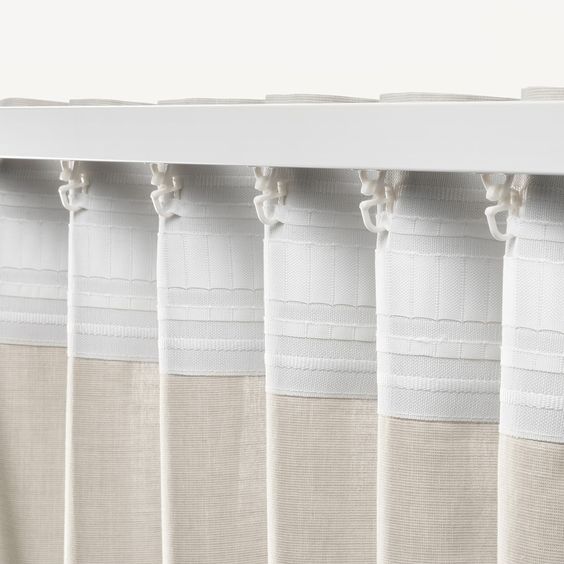
For curtain tracks, you will need drapery pins, S-hooks or drapery hooks to hang your flat panel top drapes from The White Window. Note that the S-hooks used for tracks are not the same as those used for drapery poles, so careful research is advised when you make your purchase.
How to Hang Flat Panel Curtains
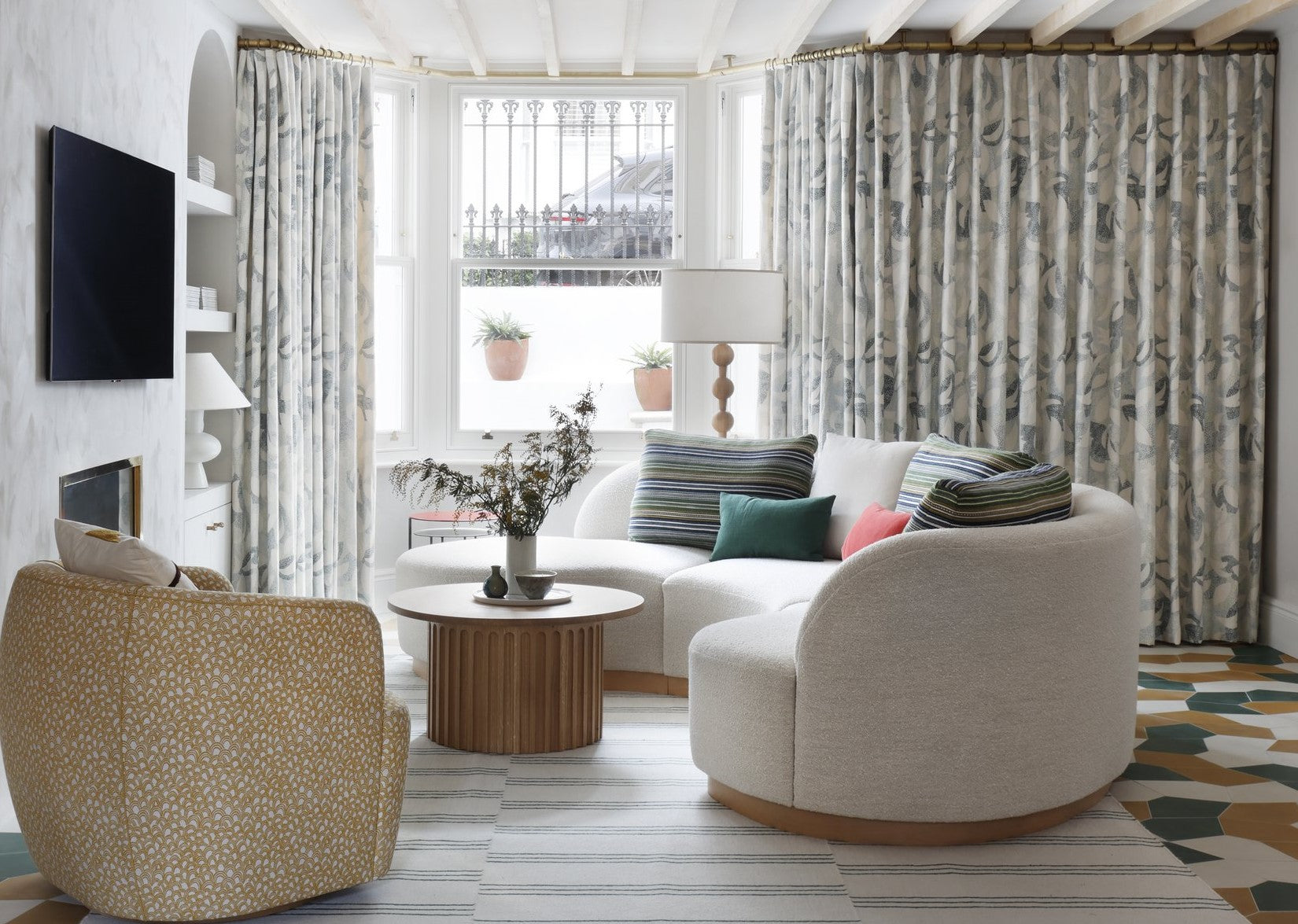
Image by Studio Peake
Installing flat panel curtains is a breeze with this detailed guide below. Here’s how:
STEP 1: Take the first step by measuring and choosing the exact insertion points of the clips/ drapery pins. There are two aspects to this point - deciding the ‘level’ at which to hang, and deciding the distance between insertion points along the header of the panel. We’ll simplify it here for you:

DECIDE THE 'LEVEL': On the backside of your flat panel top curtains from The White Window, you’ll find a 10 cm-wide heading tape sewn at the top.
Our tape features three different pin insertion points, offering three ‘levels’ to insert drapery pins. Deciding the specific ‘level’ for your curtains is the first step towards identifying the insertion points. Depending on your hardware choice, follow these simple steps:
- MOUNTING WITH DRAPERY RING & PINS: This hardware setup provides the flexibility of being able to choose how close the panel will sit to the pole/track. Choose the level that you’d like to use for the position/look that you aim for. If you choose the bottommost level, the panel will sit close to the pole, likely grazing it a bit. If using the topmost insert point closer to the seam, the panel will hang relatively lower from the pole. Note that the decision of the ‘level’ will also impact the final length of the curtain - the higher the insertion point, the lower the curtain will hang. So, in summary, choose the level of the insertion point based on two factors: how close to the pole you want the panel to sit and, where you want the curtain’s precise drop-point to be.
- MOUNTING WITH DRAPERY CLIPS: Drapery clips offer only one choice - clamping the clip to the top hem of the curtains. So, there’s only one level to hang - that’s beneath the pole.

Image by Monica Benavidez
DECIDE THE 'INTERVALS': Now that the ‘level’ is clear, it is time to decide the interval between the insertion points along the width of your panels. If you’d like your flat tops to don a dense pack of shallow pleats, keep to an interval of about 10-15cms. On the contrary, if you like to see deep pleats, let the intervals between the insertion points be about 17-20cms. It’s that simple.
Note that it is important to keep the intervals equal so that the end pleats are perfectly uniform and symmetrical. So, if you decide on an interval of 12cms, for example, maintain that throughout the header.
Now, it’s time to mark the insertion points. Here’s how you do it:
- DRAPERY RING & PIN METHOD: Remember the ‘level’ you chose - that’s the level on which you will mark the insertion points. Now, on that decided level, put a mark on one top corner of the panel - that’s where the first pin will go. Similarly, mark on the other edge too for the last pin. Now, measure the panel width between these two points. Say, it is 90cm, and you have decided on keeping an interval of 10cm, put a pencil mark after 10cm from the first insertion point. Then, follow suit until you reach the end of the tape. Thus, you will have 9 (90/10=9) points in between the hemlines and a total of 11 (9+2) insertion points for the pins.
- DRAPERY CLIP METHOD: For the drapery clip method, mark with your pencil on the top edge of the header on the rear side of the curtain. Put the first mark on the edge of the panel - that’s where the first clip will be clamped. Then, mark the other edge for the last pin. Now, measure the panel width between these two points. Say, it is 90 cms, and you have decided on keeping an interval of 15 cms, put a pencil mark after 15cms from the first insertion point. Then, follow suit till you reach the end of the tape. Hence, you will have 6 (90/15=6) points in between the hemlines and a total of 8 (6+2) points for the clips.
STEP 2: Now that you have marked the insertion points, it’s time to attach the pins/clips and hang the drapery. Here’s how you do it:

DRAPERY RING & PIN METHOD: Start inserting the drapery pins along the entire length of the tape. Ensure that the pins are inserted securely and that they don’t poke into the face fabric because they should not be visible on the frontage. Now, hook the curved end of the pin into the eyelet of the drapery ring or track carrier. Ensure that each pin is firmly secured in the hardware to prevent any slipping or sagging of the curtains. And that’s it!
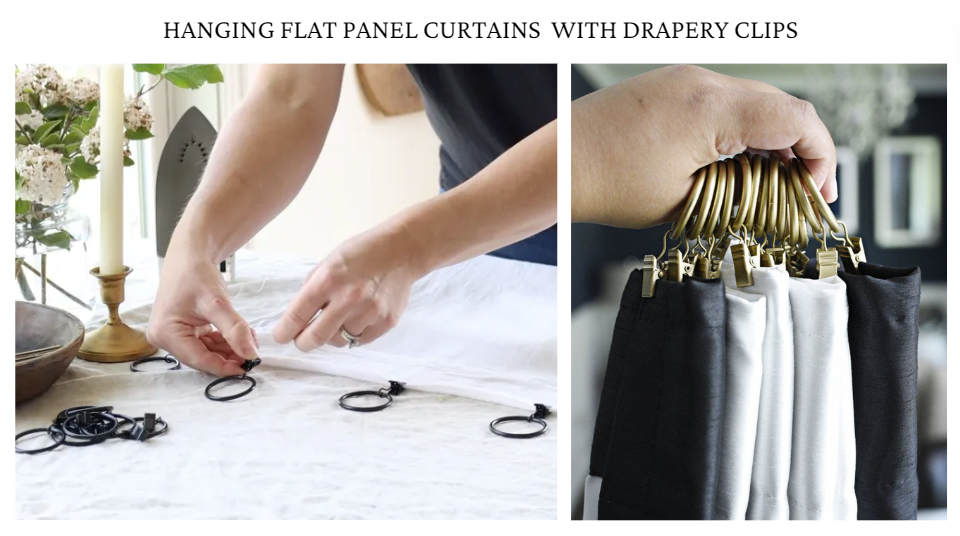
DRAPERY CLIP METHOD: Clamp the clip onto the marked insertion points on the hem of the curtain. That’s all, your curtain is ready to be hung. Feed the pole through the curtain rings, and mount the pole securely onto the brackets. And it’s a wrap!
How to Measure Flat Panel Curtains & Drapes
Flat panel top curtains provide great flexibility around their visual appeal. And so much of the execution of your plan depends on specifying the right measurements - both the length and the width. That’s why we are here to help you with all the assistance you need to use your measuring tape like a pro. Let’s unfold the measurement process step by step for you -
HOW TO MEASURE LENGTH

Flat panel top curtains can be hung from both tracks and poles. Depending on the kind of hardware you have in place or plan to purchase, the final length of your flat panel curtains will vary. So, the method of measuring the length also varies.
- CURTAIN TRACKS: When mounting on curtain tracks, the goal should be to hide the hooks/carriers on the track and your curtain panel to sit just below the track. So, measure from the underside of the track up to the desired endpoint. This will allow for the panel to cover and hide the carriers while only showing the slim profile of the track itself.
- CURTAIN POLES: If you are using curtain rings and pins to hang the flat panel, measure the length from the underside of the pole to the desired endpoint. If, on the other hand, you are using curtain clips, the length of the hardware attachment adds to the panel’s final length. So, this has to be factored in when making the measurements. So, feed the ring into the pole and then, measure from the underside of the ‘open’ clip to the desired endpoint.
As to what the endpoint should be, you may choose between any of the standard sizes of short curtains that stop at the sill or go for long curtains that reach the floor. The choice is entirely personal based on your preferences and requirements.
HOW TO MEASURE WIDTH
As mentioned earlier, the thumb rule for flat panel top curtains is to specify more width for more pleats.
Flat panel tops don their signature wavy look with well-formed pleats that are architectural yet minimalist. And the no-fail formula to achieve this aesthetic is to order 2x fullness. But what does ‘2x fullness’ mean? Let us take you through the steps to measure panel width and explain.
Start by measuring the width of your track or pole (finial to finial). Then, for 2x fullness, double this number - and this should ideally be the width of your flat panel curtains altogether.
For instance, if your pole is 100cm long, then doubling that figure to 200cm, we recommend ordering a pair of curtains with a panel width of (roughly) 100cm each, or a single panel close to 200cm.
Clients can opt to increase panel width to more than 2x fullness if shopping for sheer or semi-sheer curtains, as thin, lightweight fabrics need higher width to offer the same level of privacy and fullness as standard drapery weight fabrics.
Or perhaps you’re aiming for a ‘flatter’ look with shallower pleats to hone in on a minimalist look for your drapes. In that case, our recommendation is to order panels with 1.5x fullness i.e. simply take the pole width and multiply the number by 1.5 to determine the end panel width.
For example, if your drapery pole is 100 cm long, we recommend ordering a single drapery panel with a width of about 150 cm (100 x 1.5 = 150cm), or a pair of curtains with a panel width of (roughly) 75cm (150 cm/2) each.
However, we do not recommend going below 1.5x fullness for flat panel drapes because they may end up looking ‘stingy’ and hang like a flat sheet when drawn across the window.
In Closing
